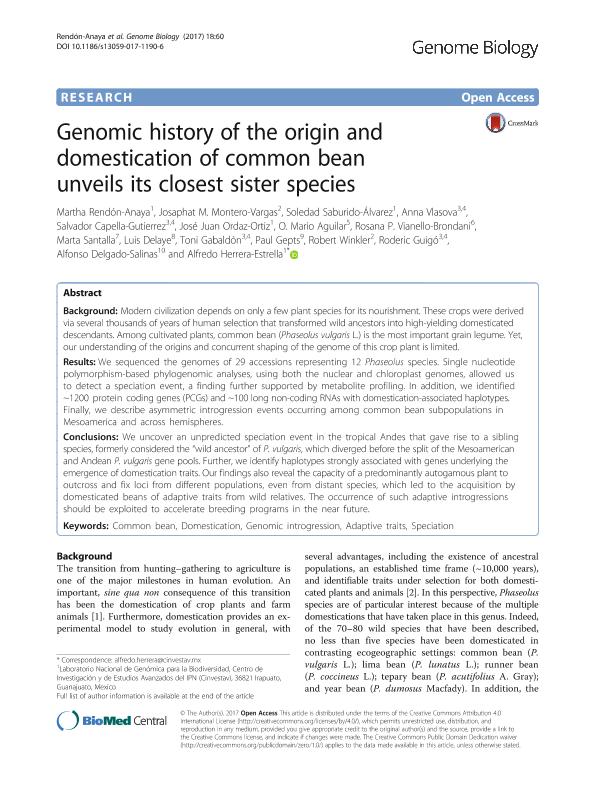Artículo
Genomic history of the origin and domestication of common bean unveils its closest sister species
Rendón Anaya, Martha; Montero Vargas, Josaphat M.; Saburido Álvarez, Soledad; Vlasova, Anna; Capella Gutierrez, Salvador; Ordaz Ortiz, José Juan; Aguilar, Orlando Mario ; Vianello Brondani, Rosana P.; Santalla, Marta; Delaye, Luis; Gabaldón, Toni; Gepts, Paul; Winkler, Robert; Guigó, Roderic; Delgado Salinas, Alfonso; Herrera Estrella, Alfredo
; Vianello Brondani, Rosana P.; Santalla, Marta; Delaye, Luis; Gabaldón, Toni; Gepts, Paul; Winkler, Robert; Guigó, Roderic; Delgado Salinas, Alfonso; Herrera Estrella, Alfredo
 ; Vianello Brondani, Rosana P.; Santalla, Marta; Delaye, Luis; Gabaldón, Toni; Gepts, Paul; Winkler, Robert; Guigó, Roderic; Delgado Salinas, Alfonso; Herrera Estrella, Alfredo
; Vianello Brondani, Rosana P.; Santalla, Marta; Delaye, Luis; Gabaldón, Toni; Gepts, Paul; Winkler, Robert; Guigó, Roderic; Delgado Salinas, Alfonso; Herrera Estrella, Alfredo
Fecha de publicación:
03/2017
Editorial:
BioMed Central
Revista:
Genome Biology
ISSN:
1474-7596
e-ISSN:
1474-760X
Idioma:
Inglés
Tipo de recurso:
Artículo publicado
Clasificación temática:
Resumen
Background: Modern civilization depends on only a few plant species for its nourishment. These crops were derived via several thousands of years of human selection that transformed wild ancestors into high-yielding domesticated descendants. Among cultivated plants, common bean (Phaseolus vulgaris L.) is the most important grain legume. Yet, our understanding of the origins and concurrent shaping of the genome of this crop plant is limited. Results: We sequenced the genomes of 29 accessions representing 12 Phaseolus species. Single nucleotide polymorphism-based phylogenomic analyses, using both the nuclear and chloroplast genomes, allowed us to detect a speciation event, a finding further supported by metabolite profiling. In addition, we identified ~1200 protein coding genes (PCGs) and ~100 long non-coding RNAs with domestication-associated haplotypes. Finally, we describe asymmetric introgression events occurring among common bean subpopulations in Mesoamerica and across hemispheres. Conclusions: We uncover an unpredicted speciation event in the tropical Andes that gave rise to a sibling species, formerly considered the "wild ancestor" of P. vulgaris, which diverged before the split of the Mesoamerican and Andean P. vulgaris gene pools. Further, we identify haplotypes strongly associated with genes underlying the emergence of domestication traits. Our findings also reveal the capacity of a predominantly autogamous plant to outcross and fix loci from different populations, even from distant species, which led to the acquisition by domesticated beans of adaptive traits from wild relatives. The occurrence of such adaptive introgressions should be exploited to accelerate breeding programs in the near future.
Palabras clave:
Adaptive Traits
,
Common Bean
,
Domestication
,
Genomic Introgression
,
Speciation
Archivos asociados
Licencia
Identificadores
Colecciones
Articulos(IBBM)
Articulos de INST.DE BIOTECNOLOGIA Y BIOLOGIA MOLECULAR
Articulos de INST.DE BIOTECNOLOGIA Y BIOLOGIA MOLECULAR
Citación
Rendón Anaya, Martha; Montero Vargas, Josaphat M.; Saburido Álvarez, Soledad; Vlasova, Anna; Capella Gutierrez, Salvador; et al.; Genomic history of the origin and domestication of common bean unveils its closest sister species; BioMed Central; Genome Biology; 18; 1; 3-2017; 1-17
Compartir
Altmétricas



